Special feature: behind the ballot and co-op cash back
Operation Round Up fuels





Geothermal isn’t just about comfort. It’s about energy independence, grid resilience, and good jobs.
Geothermal heating and cooling doesn’t just make homes more comfortable and efficient— they’re powered by a domestic, underground energy source that’s available 24/7, rain or shine.
Made in the USA: Our geothermal systems are built right here in America, supporting advanced manufacturing jobs.
Grid-friendly: While AI, EVs, and data centers push power demand to new heights, geothermal helps reduce peak load—easing the burden on our utilities.
Job-creating: From HVAC contractors and well drillers or trenchers to engineers and architects, geothermal supports a wide network of high-paying, skilled jobs in every community it touches.
Geothermal isn’t just smart for homeowners. It’s smart for the country.
Your Local WaterFurnace Dealer

Delphi
Blue Fox Htg & Clg (765) 822-2200 bluefoxhvac.com
Farmersburg
Heady Htg & Clg (812) 696-2396
Flora
Camflo Htg & Clg (574) 967-4200 camfloheatingandcooling.com
Fort Wayne
Masters Htg & Clg, Inc. (866) 824-4328 mastersingeothermal.com
Greensburg
Wallpe Htg & Clg (812) 663-7252 wallpegeothermal.com
Indianapolis
Masters Htg & Clg by Van Valer, Inc. (317) 881-9074 mastersingeothermal.com
Jasper Hulsman Refrigeration, Inc. (812) 634-1492 hulsmanrefrigeration.com
Laotto
T&T Plbg, Htg, A/C & Geothermal (260) 200-4003 tt-ph.com
Lebanon
Blue Fox Htg & Clg (765) 859-0880 bluefoxhvac.com
Nappanee
Crist Plbg, Htg, Electrical (574) 831-4630 cristnappanee.com
North Manchester Mars Refrigeration, LLC (260) 901-0057
North Vernon Air One Htg & Clg, Inc. (888) 346-1790 aironehvac.com
Ossian Collier’s Comfort Services (260) 622-6622 collierscomfort.com

Warsaw

Colliers Htg & Air Conditioning (574) 203-2492 trustcolliers.com
Waterloo
Gibson’s Htg & Plbg, Inc. (888) 754-1668 gibsonsgeothermal.com
Westfield
Precision Comfort Systems, Inc. (317) 867-2665 precisioncomfort.com
West Lafayette Blue Fox Htg & Clg (765) 252-0051 bluefoxhvac.com
from the editor
A life-changing program
This month’s feature story highlights the Pets Healing Vets program at the Humane Society for Hamilton County. Pets Healing Vets connects rescue dogs and cats with qualifying Indiana veterans who suffer from PTSD or traumatic brain injury. While other shelters nationwide have programs that pair military veterans with rescue animals, Pets Healing Vets is the only program that covers the cost of pet food and healthcare for the animals’ entire lives.
I first learned about this program from a friend who works with doctors to improve the opioid crisis in Indiana. He had attended presentations given by Justin Morseth, whose wife was inspired to create Pets Healing Vets after seeing his relationship with their rescue Alaskan Husky. As someone who loves animals, I was interested in the impact companion animals could have on people with PTSD and anxiety, and how they could live fuller lives without relying heavily on medication.
I was amazed by the veterans and their dogs featured in our story, but I was blown away by the bond between the pairs when I saw it firsthand. Kiley, our Indiana Connection photographer, and I visited the Humane Society to capture some of the photos you see in the story. You could feel the connection between Emily and Caesar and how they are truly a bonded pair.
We were also impressed with the Humane Society’s team and their dedication to Pets Healing Vets. They are sincerely committed to making these pairings successful, not just at the initial adoption but throughout the pet’s life. They run this program with remarkable compassion for both veterans and animals. I hope you read more about this special program on page 20.


Britt Davis Editor bdavis@indianaec.org
On the menu: February: Submit your favorite red velvet recipes, deadline Dec. 1. If we publish your recipe on our food pages, we’ll send you a $10 gift card.
Giveaway: Enter to win a pet gift basket. Visit indianaconnection.org/talk-to-us/contests or send your contact information to the address below. The deadline to enter is Nov. 30.
Three ways to contact us: To send us recipes, photos, letters and entries for gift drawings, please use the forms on our website indianaconnection.org; email info@indianaconnection.org; or send to Indiana Connection, 11805 Pennsylvania Street, Carmel, IN 46032.
VOLUME 75 • NUMBER 5 ISSN 0745-4651 • USPS 262-340
Published monthly by Indiana Electric Cooperatives
Indiana Connection is for and about members of Indiana’s locally-owned, not-for-profit electric cooperatives. It helps consumers use electricity safely and efficiently; understand energy issues; connect with their co-op; and celebrate life in Indiana. Over 320,000 residents and businesses receive the magazine as part of their electric co-op membership. The average printed and mailed cost per issue is 54 cents.
CONTACT US: 11805 Pennsylvania Street Carmel, IN 46032 317-487-2220
info@indianaconnection.org IndianaConnection.org
INDIANA ELECTRIC COOPERATIVES OFFICERS: Steve McMichael President
Dr. Richard Leeper Vice President
Jamey Marcum Secretary/Treasurer
John Cassady CEO
EDITORIAL STAFF:
Britt Davis Editor
Mandy Barth Vice President of Communication
Lauren Carman Communication Manager
Ashley Curry Production and Design Coordinator
Holly Huffman Communication Support Specialist
Amber Knight Creative Manager
Kiley Lipps Graphic Designer
ADVERTISING:
American MainStreet Publications Cheryl Solomon, local ad representative; 512-441-5200; amp.coop
Paid advertisements are not endorsements by any electric cooperative or this publication.
UNSOLICITED MATERIAL:
Indiana Connection does not use unsolicited freelance manuscripts or photographs and assumes no responsibility for the safekeeping or return of unsolicited material.
SUBSCRIPTIONS: $12 for individuals not subscribing through participating REMCs/RECs.
CHANGE OF ADDRESS:
If you receive Indiana Connection through your electric co-op membership, report address changes to your local co-op.
POSTAGE:
Periodicals postage paid at Indianapolis, Indiana, and at additional mailing offices.
POSTMASTER: Send change of address to: Indiana Connection, 11805 Pennsylvania Street, Carmel, IN 46032. Include key number.
No portion of Indiana Connection may be reproduced without permission of the editor.




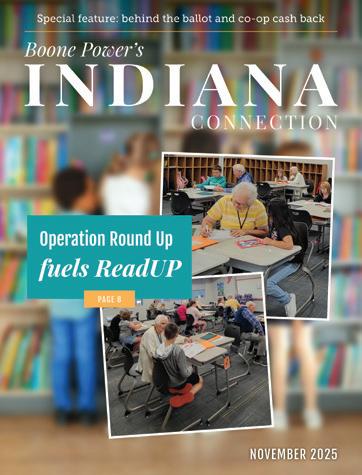
CONTACT US
800-897-7362
WEBSITE boonepower.com
EMAIL contactus@boonepower.com
OFFICE HOURS
7:30 a.m.-4:30 p.m.
STREET ADDRESS
1207 Indianapolis Ave.
Lebanon, IN 46052
MAILING ADDRESS
P.O. Box 563
Lebanon, IN 46052
POWER OUTAGES
The easiest way to report a power outage is on the SmartHub mobile app.
BOARD OF DIRECTORS
District 1 — W. Daniel Lawson
District 2 — Thomas E. Dull
District 3 — Mark Gruninger
District 4 — Brian Gott
District 5 — Jon Stevens
District 6 — Alan D. Cragun
District 7 — Bruce Guernsey
District 8 — Mark Starkey
District 9 — Noel R. Kendall
READ ONLINE!
Find a digital flipbook version of the magazine on the SmartHub mobile app or on our website.
Follow us on social media for energy-saving tips and important updates and reminders.
Join us on Nov. 11 for our
Mastering SmartHub presentation
Tuesday, Nov. 11, 2025
Lebanon Public Library, Crawford Meeting Room 5:30–7:30 p.m.
Learn how to make the most of SmartHub, Boone Power’s easyto-use account management tool.
WE’LL COVER HOW TO:
• View and pay your bill
• Track daily energy use
• Report service issues
• Set alerts and reminders Bring your device for handson help! Light refreshments provided. Register today at boonepower.com/ member-ambassadors
This event is part of our Member Ambassadors of the Cooperative (MAC) educational series. As a memberowned cooperative, we’re committed to engaging with those we serve. That’s why we host MAC events three times a year, focusing on topics related to the electric industry and Boone Power programs and services. By attending these events, you become a Boone Power Ambassador, gaining insight into your co-op’s projects and programs, and industry trends, helping us share the Boone Power story by staying informed and connecting with fellow members.

BEHIND THE BALLOT:
Understanding your electric cooperative election
At Boone Power, our members aren’t just customers — you are owners. One of the most important ways you exercise that ownership is by electing your electric co-op’s board of directors.
Each spring, members elect directors to help guide Boone Power’s future. Directors are elected to serve three-year terms. Article IV of our bylaws (available at boonepower.com/bylaws ) outlines the process clearly, but we want to make sure every member understands how it works and how they can participate.
How the process works
• MEMBER PETITIONS: Any member residing in the districts up for election may seek election by collecting signatures from 3% of the members in their district and submitting an interest form. In 2026, directors will be elected from districts 1, 2, and 3. Petitions are due by Jan. 30.
• NOMINATING COMMITTEE:
Each year, a committee of fellow members is appointed by the board to identify candidates for any upcoming vacancies. The eligibility of any petitioners and incumbent candidates is verified.
• ELECTIONS: Each year, members vote for candidates in three of the nine districts. Members can vote for each district up for election each year, regardless of their residence’s district. Members have several options for voting including online, by mail, or in person.
Why some elections are uncontested
Boone Power’s elections don’t require multiple candidates.
Serving as a director is a significant responsibility; it involves time, training, and a commitment to act in the best interest of all members. Some years, the incumbents are the only members to express their desire to serve (in this case, continue serving) as a board director. When that happens, the election still takes place according to our bylaws.
Why your vote still matters
Even in years when races are uncontested, your participation is vital. By casting a ballot, you:
• Help us reach the quorum our bylaws require, ensuring the election is valid.
• Affirm your directors’ commitment to serve.
• Demonstrate that members remain actively engaged in cooperative governance.
The cooperative difference Cooperatives operate under the principle of Democratic Member Control — meaning members ultimately guide the organization. Unlike investor-owned utilities, Boone Power’s board directors are your neighbors and are accountable to you. Whether contested or uncontested, the process ensures that members always have both the right to run and the right to vote.
How you can get involved
If you’ve ever considered serving, we encourage you to learn more by visiting boonepower.com/ board-of-directors . You may also contact our office with questions about the process or petition requirements. Your participation, whether by voting or serving on the board, ensures Boone Power remains a member-led, member-owned organization.
Stay tuned to upcoming magazine issues and our website for more details about the 2026 election.

Districts 1, 2, and 3 will be elected in 2026.
Districts 4, 5, and 6 will be elected in 2027.
Districts 7, 8, and 9 will be elected in 2028.
CAPITAL CREDITS ARE THE CO-OP VERSION OF ‘CASH BACK’
As our President and CEO, Bill Conley, shared in last month’s magazine, Boone Power takes our cooperative business model seriously and remains committed to fairness, reliability, and transparency. Retiring capital credits is one of the unique business practices of cooperatives. Learn more about how this “cash back” process is built into our business model.
Being a cooperative means you, as a customer, are also a member-owner. When you pay your electric bill, you gain equity in our cooperative and share in its financial success. We don’t exist to make a profit. We use operating capital to maintain and improve our distribution system so that we can carry out our mission of providing the most reliable electric service possible.
Did you know?
Our record of reliability means Boone Power members experience 65% less outage time than their neighbors served by investor-owned utilities. From 20202024, Boone Power members averaged just 1 hour and 40 minutes without power each year, far below nearby investor-owned utilities, which average 4 hours and 43 minutes.
Statistics based on System Average Interruption Duration Index (SAIDI), which is the average minutes of interruption per customer. It is calculated by dividing the sum of all customer interruption durations (in minutes) by the total number of customers. [Sources: Indiana Utility Regulatory Commission; National Rural Utilities Cooperative Finance Corporation]
1 You use power.
4 You build up credits.
After all expenses are paid each year, any remaining margins are credited to each member’s account according to the amount of electricity purchased. Think of it like a rewards or loyalty program — every kilowatt-hour you use builds up “points.” We call these “points” capital credits.
Assigning capital credits to members, instead of paying dividends to distant stockholders, is one of the ways your cooperative puts ownership into action.
Your equity in the co-op reduces the need for us to raise rates or borrow as much money (and pay as much interest) for expenses. The board of directors decides when to return some funds to members based on the cooperative’s financial condition. Capital credit disbursements can run years behind since margins are used to maintain our electric distribution system.
2 You pay your bill.
3 Boone Power invests in reliable service.
For more information about capital credits, including a list of frequently asked questions, visit boonepower.com/capital-credits How it works
Just like you are a member-owner of Boone Power, Boone Power is a member-owner of Wabash Valley Power Alliance (WVPA), the cooperative that provides the electricity that we buy and deliver to our customers. So, when Boone Power gets capital credits from WVPA, we can pass those on to our member-owners.
This year’s disbursement — nearly $142,000 — is a direct payment from WVPA for a portion of 2010.
Members receiving capital credits this year will see a line item on their November billing statements called “Co-op Cash Back.”
Operation Round Up fuels ReadU P
By Juli Knutson
Discovering the magic of reading is life changing.
That is just what’s happening in the ReadUP program, which Boone Power’s Operation Round Up program recently assisted.
This past summer, Boone County Mentoring Partnership (BCMP) received a grant for the ReadUP program through Operation Round Up, an initiative Boone Power started in 2006 to provide funds for nonprofit organizations. The program is funded by members who allow their monthly electric bill payments to be rounded up to the next highest dollar.
ReadUP assists local third graders who need extra support with reading and comprehension. Each week, caring adult volunteers read with two students for 30 minutes to improve their skills to meet and maintain grade-level standards. Currently, volunteers log more than 700 hours of reading with students per semester!
Third grade is a pivotal year, when students move from learning to read to reading to learn. Success at this stage is often a strong indicator of future academic achievement.
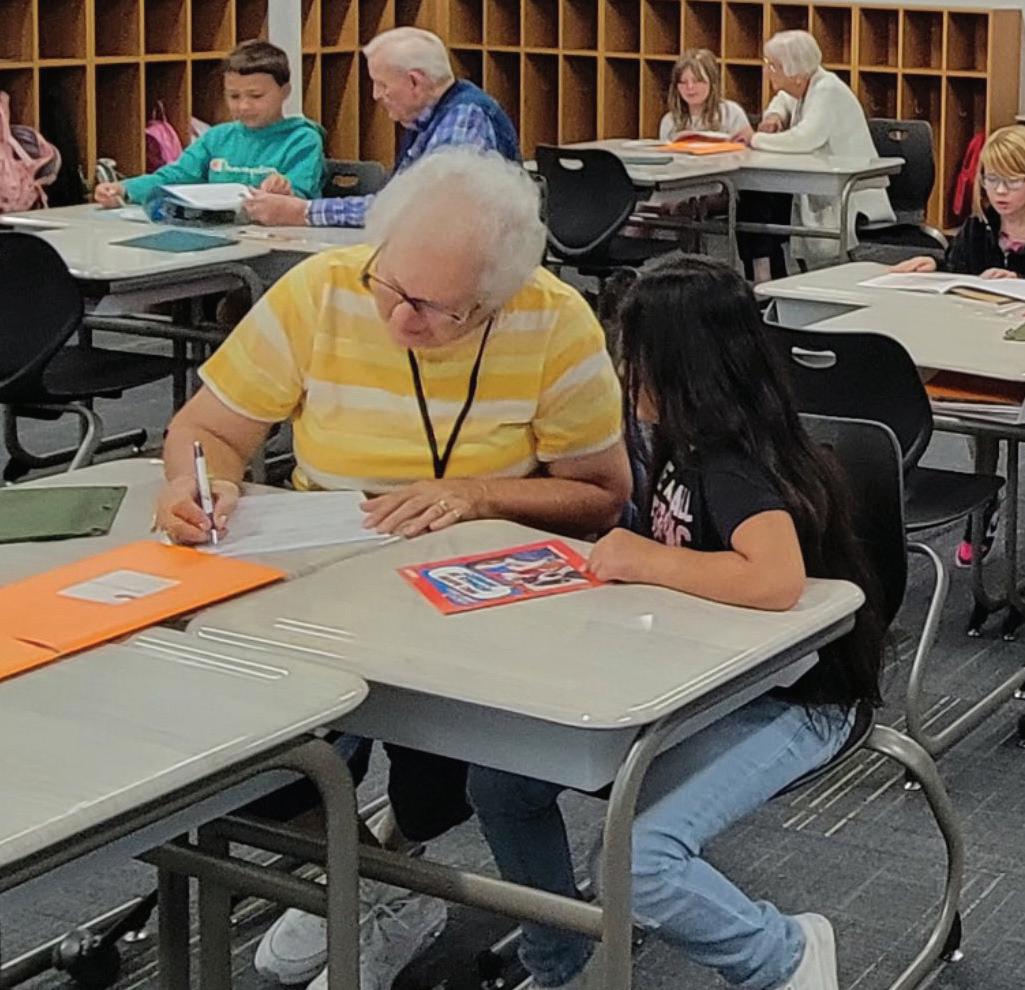
This important program is a collaboration between BCMP and United Way of Central Indiana to empower young learners.
“Our intent for the grant was to get more books in kids’ hands,” said BCMP Executive Director Matt Wilson. “We wanted to build our ReadUP library with the more popular books and to occasionally give kids books of their own to take home. We want to create more choices so the kids will really enjoy reading. This grant funded about 200 additional books.”
In addition to ReadUP, Boone County Mentoring Partnership works to unlock potential, helping kids of all ages with one-on-one mentoring, a resource hub, and graduation coaching. The goal is to provide the tools they need to graduate from high school and launch into a promising future. Wilson is thankful for the Operation Round Up grant, and in time, hopes to expand the ReadUP program beyond the three Lebanon elementary schools currently served.
This will require more volunteers and resources. Visit boonecountymentoring.org to learn how you can get involved.
“It’s really fun,” said Kiera Hall, ReadUp program manager. “The students and volunteers build a mentoring relationship — so it’s not just reading together. The volunteers are asking about their day. They’re helping them through any challenges that they’re going through, so that real, intergenerational relationship is really important.”
Boone Power members continuously impact the community through their participation in Operation Round Up, which awards grants to nonprofits each quarter.
“During this season of thanksgiving, Boone Power would like to express sincere appreciation for our members who contribute to Operation Round Up,” said Mandy Saucerman, Boone Power director of communications. “Your support plays an essential role in empowering our neighbors and making a meaningful impact in the communities we serve.”
Juli Knutson is a freelance writer in Central Indiana.
energy POWERING THROUGH INDIANA’S STORMS
How to choose the right generator for your home
In Indiana, whether it’s summer or winter, storms can quickly cause power outages that last for extended periods. That means having a generator to power your home can be critical. Choosing the right type and size of generator is equally important.
PORTABLE GENERATORS
Portable generators range from small units that can power a single home appliance or be used when camping or tailgating to larger units that can provide power for the majority of a home’s needs. Depending on the wattage and the brand, the price can range from $400 to $2,000. Larger portable generators can burn through 20 gallons of gasoline per day.
INVERTER GENERATOR
Another option is an inverter generator. It throttles the engine up and down to supply power more efficiently, but these tend to be more expensive, ranging from $300 for units less than 1,500 watts up to $5,000 for units 5,000-plus watts and 220-volt capable.
STANDBY GENERATORS
There are also home standby generators that generally cost

between $5,000 and $7,000. However, they require permanent installation, which will cost more.
FINDING THE RIGHT SIZE
How do you determine the right generator size for your needs?
• Decide what appliances and systems you want to power.
• Add up the wattage for all of those appliances and systems.
• Choose a generator that is no more than 20% larger than your total wattage requirement. If you choose a generator that produces much more power than you’re using, you’re being energy inefficient and costing yourself money.
• Consider using smart load management systems to prevent oversizing.
• For accurate sizing, use online calculators or consult with an energy efficiency professional. If you have questions, contact your cooperative.
The bottom line is that envisioning your home without power is the best way to determine your needs. What would you need depending on the length of an outage? Your needs for an extended outage will give you an idea of where to start sizing your generator.
Once you settle on a generator, remember that it should be installed with a proper transfer switch to prevent it from backfeeding the grid and possibly endangering the lineworkers attempting to restore power.
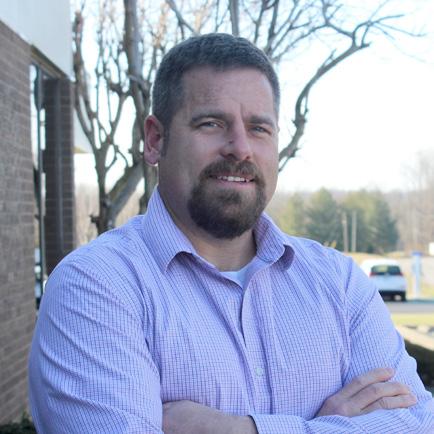
by Nick Geswein Energy Advisor

Owen County COUNTY FACTS
About 30 minutes from Bloomington, Indiana, lies Owen County. In 1920, the mean center of the United States population — a statistical point representing the average location of all Americans — was located eight miles southeast of Spencer, the county seat. Today, Owen County is known for its outdoor recreation and for hosting VentFest, the country’s only international ventriloquism festival. Held each June, this threeday, family-friendly event showcases talented ventriloquists from around the world at Spencer’s Historic Tivoli Theatre.
NOW SHOWING
The Historic Tivoli Theatre in Spencer opened in 1928 with a showing of “The Shopworn Angel,” a part-talking sound romantic drama film starring Gary Cooper and Nancy Carroll. American sculptor Ernest Moore Viquesney founded the theater. After closing in 1999, the Tivoli was restored in 2013 through a partnership between Owen County Preservations, Indiana Landmarks, and the Cook Group. Today, movie-goers can watch new releases and classics with $5 tickets for adults and $3 for children. The Tivoli also offers private screenings and a 12-seat balcony rental with a bird’s-eye view of its silver screen.

INDIANA’S CENTENNIAL CANYON
Established in 1916 during Indiana’s centennial celebration, McCormick’s Creek State Park is the oldest of Indiana’s 25 state parks. Each year, about 640,000 visitors come to Spencer to explore the park’s limestone canyon, which rises 700 feet above sea level. Visitors can also stay at the Canyon Inn, a 76-room hotel with a gift shop, restaurant, and common areas. Initially built in 1888 as a sanitarium by Dr. Frederick Denkewalter, the building was later renovated into a hotel in the 1920s.

FOUNDED: 1819
NAMED FOR: Abraham Owen, a U.S. Army colonel in the Battle of Tippecanoe
POPULATION: 21,851
COUNTY SEAT: Spencer
INDIANA COUNTY NUMBER: 60

SPENCER’S ROARING LANDMARK
Cataract Falls, Indiana’s largest waterfall by volume, is in Spencer. It consists of two separate waterfalls, one mile apart along Mills Creek. Its upper falls drop 45 feet while its lower falls drop 30 feet. Just south of the waterfalls is the Cataract Falls Covered Bridge, the only remaining covered bridge in Owen County. The Smith Bridge Company from Toledo, Ohio, built the bridge in 1876. Only six Smith trusses still exist in Indiana today.
By Nicole Thomas
United States Postal Service Statement of Ownership, Management and Circulation
1. Publication Title: Indiana Connection. 2. Publication Number: 0745-4651. 3. Filing Date 9/30/25. 4. Issue Frequency: Monthly. 5. Number of Issues Published Annually: 12. 6. Annual Subscription Price: $5.16. Complete Mailing Address of Known Office of Publication: Indiana Electric Cooperatives, 11805 Pennsylvania Street, Carmel, IN 46032-4555. Contact Person: Britt Davis. Telephone: 317-260-1934. 8. Complete Mailing Address of Headquarters or General Business Office of Publisher: Indiana Electric Cooperatives, 11805 Pennsylvania Street, Carmel, IN 46032-4555. 9. Full Names and Complete Mailing Address of Publisher, Editor, and Managing Editor: Publisher: Indiana Electric Cooperatives, 11805 Pennsylvania Street, Carmel, IN 46032-4555. Editor: Britt Davis, Indiana Electric Cooperatives, 11805 Pennsylvania Street, Carmel, IN 46032-4555. Managing Editor: N/A. 10. Owner: Indiana Electric Cooperatives, 11805 Pennsylvania Street, Carmel, IN 46032-4555. 11. Known Bondholders, Mortgagees, and Other Security Holders Owning or Holding 1 Percent or More of Total Amount of Bonds, Mortgages, or Other Securities: None. 12. Tax Status (For completion by nonprofit organizations authorized to mail at nonprofit rates). The purpose, function, and nonprofit status of this organization and the exempt status for federal income tax purposes has not changed during preceding 12 months. 13. Publication Title: Indiana Connection. 14. Issue Date for Circulation Data Below: Oct. 2025. 15. Extent and Nature of Circulation: Electric operative members in Indiana. a. Total Number of Copies (Net press run): Average No. Copies Each Issue During Preceding 12 Months: 318,454. No. Copies of Single Issue Published Nearest to Filing Date: 321,146. b. Paid Circulation (By Mail and Outside the Mail). (1) Mailed Outside-County Paid Subscriptions Stated on PS Form 3541 (Include paid distribution above nominal rate, advertiser’s proof copies and exchange copies): Average No. Copies Each Issue During Preceding 12 Months: 317,412. No. Copies of Single Issue Published Nearest to Filing Date: 320,109. (2) Mailed In-County Paid Subscriptions Stated on PS Form 3541 (Include paid distribution above nominal rate, advertiser’s proof copies and exchange copies): Average No. Copies Each Issue During Preceding 12 Months: 0. No. Copies of Single Issue Published Nearest to Filing Date: 0. (3) Paid Distribution Outside the Mails including Sales Through Dealers and Carriers, Street Vendors, Counter Sales, and Other Paid Distribution Outside USPS: Average No. Copies Each Issue During Preceding 12 Months: 0. No. Copies of Single Issue Published Nearest to Filing Date: 0. (4) Paid Distribution by Other Classes of Mail Through the USPS (e.g. First-Class Mail): Average No. Copies Each Issue During Preceding 12 Months: 0. No. Copies of Single Issue Published Nearest to Filing Date: 0. c. Total Paid Distribution ((Sum of 15b (1), (2), (3), and (4)): Average No. Copies Each Issue During Preceding 12 Months: 317,412. No. Copies of Single Issue Published Nearest to Filing Date: 320,109. d. Free or Nominal Rate Distribution (By Mail and Outside the Mail). (1) Free or Nominal Rate Outside-County Copies included on PS Form 3541: Average No. Copies Each Issue During Preceding 12 Months: 163. No. Copies of Single Issue Published Nearest to Filing Date: 162. (2) Free or Nominal Rate Copies In-County Copies Included on PS Form 3541: Average No. Copies Each Issue During Preceding 12 Months: 0. No. Copies of Single Issue Published Nearest to Filing Date: 0. (3) Free or Nominal Rate Copies Mailed at Other Classes Through the USPS (e.g. First-Class Mail): Average No. Copies Each Issue During Preceding 12 Months: 0. No. Copies of Single Issue Published Nearest to Filing Date: 0. (4) Free or Nominal Rate Distribution Outside the Mail (Carriers or other means): Average No. Copies Each Issue During Preceding 12 Months: 0. No. Copies of Single Issue Published Nearest to Filing Date: 0. e. Total Free or Nominal Rate Distribution (Sum of 15d (1), (2), (3) and (4): Average No. Copies of Each Issue During Preceding 12 Months: 163. No. Copies of Single issue Published Nearest to Filing Date: 162. f. Total Distribution (Sum of 15c and 15e): Average No. Copies Each Issue During Preceding 12 Months: 317,575. No. Copies of Single Issue Published Nearest to Filing Date: 320,271. g. Copies not Distributed (See Instructions to Publishers #4 (page #3): Average No. Copies Each Issue During Preceding 12 Months: 878. No. Copies of Single Issue Published Nearest to Filing Date: 875. h. Total (Sum of 15f and g): Average No. Copies Each Issue During Preceding 12 Months: 318,453. No. Copies of Single Issue Published Nearest to Filing Date: 321,146. i. Percent Paid (15c divided by 15f times 100): Average No. Copies Each Issue During Preceding 12 Months: 99.95%. No. Copies of Single Issue Published Nearest to Filing Date: 99.95%. 16. Electronic Copy Circulation. A. Paid Electronic Copies: Average No. Copies Each Issue During Preceding 12 Months: 0. No. Copies of Single Issue Published Nearest to Filing Date: 0.b. Total Paid Print Copies (Line 15c) + Paid Electronic Copies (Line 16a): Average No. Copies Each Issue During Preceding 12 Months: 317,412. No. Copies of Single Issue Published Nearest to Filing Date: 320,109. c. Total Print Distribution (Line 15f) + Paid Electronic Copies (Line 16a): Average No. Copies Each Issue During Preceding 12 Months: 317,575. No Copies of Single Issue Published Nearest to Filing Date: 320,271. d. Percent Paid (Both Print & Electronic Copies (16b divided by 16c X 100): Average No. Copies Each Issue During Preceding 12 Months: 99.94%. No. Copies of Single Issue Published Nearest to Filing Date: 99.94%. I certify that 50% of all my distributed copies (electronic and print) are paid above a nominal price. Publication of Statement of Ownership. If the publication is a general publication, publication of this statement is required. Will be printed in the November 2025 issue of this publication. 17. Signature and Title of Editor, Publisher, Business Manager or Owner (Signed): Britt Davis, Editor. Date: 9/30/25
I certify that all information furnished on this form is true and complete. I understand that anyone who furnishes false or misleading information on this form or who omits material or information requested on the form may be subject to criminal sanctions (including fines and imprisonment) and/or civil sanctions (including civil penalties).
Order your 2026 CALENDAR TODAY!
SEND US A CHECK AND A NOTE WITH YOUR NAME AND ADDRESS. COPIES OF THE COOPERATIVE CALENDAR OF STUDENT ART ARE $7 EACH.
The price includes shipping and Indiana sales tax. Make the check payable to “Indiana Electric Cooperatives.” Send your order to Indiana Electric Cooperatives, 11805 Pennsylvania Street, Carmel, IN 46032.

Limited quantities of the 2026 Cooperative Calendar of Student Art are available at participating electric cooperative offices across the state.
• Bartholomew County REMC
• Carroll White REMC
• Clark County REMC
• Daviess-Martin County REMC
• Dubois REC
• Fulton County REMC
• Harrison REMC
• Heartland REMC
• Jasper County REMC
• Jay County REMC
• JCREMC
• Kankakee Valley REMC
• Kosciusko REMC
• LaGrange County REMC
• Marshall County REMC
MARKETPLACE
• Newton County REMC
• Noble REMC
• Orange County REMC
• RushShelby Energy
• Whitewater Valley REMC
• WIN Energy REMC
Our Marketplace offers maximum exposure for your business or organization at a minimal cost.
Please contact Cheryl Solomon, 847-749-4875 or cheryl@amp.coop , for other small business advertising opportunities in Indiana C onnection .
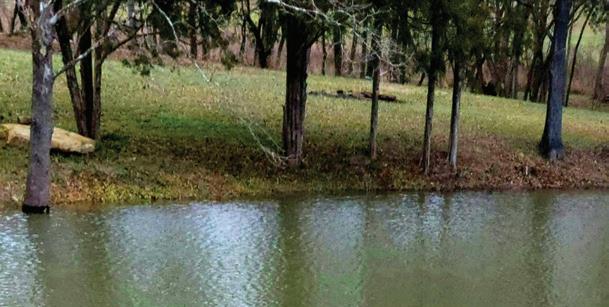




Indiana eats

Eclectic dining and timeless charm
By Veni Fields
When a man from Pennsylvania meets a woman from Michigan in Texas, and they settle in Indiana and open a restaurant, the menu is bound to be eclectic.
Nick and Charity Boyd’s South Side Soda Shop in Goshen has a history as colorful as its offerings. It’s tucked in a cozy neighborhood setting that reflects its moniker as “a family-run retro diner with a modern twist.”
A MENU FULL OF SURPRISES
Opened in 1910 as a grocery store that included a post office and later a bus stop, the building became a soda shop in 1940, which closed in the early 1980s. The Boyds bought and renovated it, opening as the South Side Soda Shop in 1986, and added the diner-style “sidecar” around 1994.
“It’s special,” said Nick Boyd. “Sometimes people are surprised when they come in.” Some surprised customers include one from Philadelphia who noted the authentic Amoroso rolls for the Philly
cheesesteaks, children who love the snapping turtle soup, and those who appreciate the fresh oysters. “People love to watch us shuck the oysters,” said Boyd.
“They also love having sodas mixed on the spot with syrup and carbonated water,” said Charity. Listed on the menu as “Phosphates” in a nod to vintage soda shop terminology, South Side Soda Shop lists nine flavors, including vanilla, cherry, chocolate, and a customer favorite, Green River, with an emerald-hued fizz.
The restaurant’s soups, salads, sandwiches, and grilled fare are equaled on the sweeter side of the menu with floats, malts, shakes, and sundaes, and a long list of pies and cakes made in-house by the Boyds’ daughter, Nicole. Their lemon meringue, with a mountain of crispy whisps on top, won the Indiana Pie Quest.
MOMENTS IN THE SPOTLIGHT
The place left such an impression on a former employee, who became a filmmaker in New York City, that it was
written into the 2006 film, "Lonesome Jim," with Casey Affleck and Liv Tyler, directed by Steve Buscemi.
The restaurant also caught the attention of Food Network’s "Diners, Drive-Ins, and Dives," with Guy Fieri, twice: once in the show’s inaugural season in 2007 and again this year, with an episode to air in 2026.
While the fame has been life-changing, said Boyd, and has brought in people from all over the country, the creativity and passion of perhaps a few unexpected and well-made dishes is what the Boyds believe has put them on the map and kept them here to stay.
“We have customers who came here when we first opened,” said Boyd. “Now they bring in their children and grandchildren. That’s the best.”
SOUTH SIDE SODA SHOP
1122 South Main St
Goshen, IN 46526
574-534-3790

southsidesodashop.com









































safety
CHARGE AHEAD WITH SAFETY
Prevent fires and ensure safe charging when using lithium-ion batteries
By Chris Adam
Lithium-ion batteries are regularly found in everyday items such as mobile phones and laptops. They also power devices such as e-bikes, e-scooters, electric vehicles, and systems routinely used by first responders.
If you regularly travel by plane, you’re likely aware of specific concerns about lithium-ion batteries. The Federal Aviation Administration warns travelers about fire dangers and other battery concerns.
These batteries are practical and efficient power sources, but they can overheat, catch on fire, and even explode, especially when damaged or improperly used and stored.
“As the use of batterypowered items has increased in recent years, so too has the number of fires associated with them,” said John Cassady, CEO of Indiana Electric Cooperatives.
“It’s crucial for individuals and families to know about battery safety and how to use, store, and charge them.”
One important thing to know about lithium-ion batteries is that they store a large amount of energy in a small space. They should be used properly for their intended purpose. At the same time, like other products, some of these batteries can be defective and may overheat, catch fire, or explode.
HERE ARE SOME SAFETY TIPS TO REMEMBER WHEN USING LITHIUM-ION BATTERIES:
• Purchase and use devices that have been reviewed by a qualified testing laboratory.
• Always follow the manufacturer’s instructions.
• Only use the battery that is designed for that device.
• Put batteries in the device the right way.
• Use only the charging cord that came with the device.
• Do not charge a device under your pillow, on your bed, or on a couch.
• Do not keep charging the device or the battery after it is fully charged.
• Store batteries away from direct heat or anything that can catch fire.
Stop using a battery or device if you notice a strange odor, too much heat, a change in shape, leaking, or odd noises. Do not put lithium-ion batteries in the trash. Always recycle the batteries or electric devices at a specified recycling location.
Share these safety tips with the younger people in your life. Since lithium-ion batteries power their devices, you want to be sure they know about the dangers and how to minimize them.












Heartwarming comfort food
As the weather cools, nothing beats a comforting home-cooked meal and a cozy night in. Each of these dishes offers charm and warmth and is great for sharing.
½ cup unsalted butter, softened
2 ⁄ 3 cup sugar
2 eggs
3 very ripe bananas
½ tsp vanilla
1½ cups flour
1 tsp salt
1¼ cup mini semi-sweet chocolate chips
Preheat the oven to 350 F. Grease a loaf pan or line it with parchment paper. Cream the butter and sugar. Mix in the eggs. Mash the bananas with a fork until chunky, not mushy. Combine the bananas and vanilla with the mixture. Add the flour and salt. Stir until just combined. Fold in the cup of chocolate chips. Use the remaining chips to sprinkle on top. Bake for 55 to 60 minutes, checking if the bread is done in the center.

FOOD PREPARED BY INDIANA CONNECTION STAFF
PHOTOS BY KILEY LIPPS

FRENCH
2 lbs round steak, cubed pieces
¼ cup butter
1 packet dry onion soup mix
1 cup dry red wine
1¼ cups water
Salt and ground black pepper to taste
Preheat the oven to 350 F. In a 10-inch skillet, add the butter and cubed meat, and brown the meat. Once browned, drain and discard the butter. Remove the meat and transfer it to a large, oven-safe casserole dish. Add the dry onion soup mix and stir to combine. Pour the red wine and water over the meat and tightly cover with foil. Bake for about two hours or until the meat is tender. Remove the casserole from the oven and let it rest for three to five minutes. Peel off the foil and serve hot, using a large spoon over mashed potatoes, buttered noodles, or rice.
SLOW COOKER CHICKEN CHILI Marilles Mauer, Greensburg
2 lbs boneless chicken breast
1 medium yellow onion
1 (16 oz) bag of frozen corn
2 (15 oz) cans black beans
2 (10 oz) cans tomatoes with green chilis
4 cups chicken broth
1 (12 oz) package of bacon
2 packets of ranch dressing mix
2 tsp cumin
2 Tbsp chili powder
2 (8 oz) packages of cream cheese
Shredded cheddar cheese for topping
Place all ingredients except the bacon into a slow cooker. Put the chicken at the bottom to sit during cooking. Cook for four hours on high. Stir once or twice cooking during process. While the soup cooks, fry the bacon. Cool and crumble, then add it to the soup in the last hour. After four hours, remove the chicken and shred it. Return the shredded chicken to the cooker and stir everything together. Serve topped with shredded cheese.


Saving lives ON BOTH ENDS OF THE LEASH
By Brian D. Smith
Justin Morseth returned from the Iraq War a lucky man. Despite serving as an infantry captain on the front lines of the conflict, he managed to avoid serious injury. His meritorious service earned him two Bronze Stars — one with the added distinction of Valor — and when he left the U.S. Army in 2003, he seemed ready to resume normal life in Indiana.
But he and his wife, Megan, would soon discover that he wasn’t quite as unscathed as he thought. Behavior that made sense in Iraq, such as carrying a knife to the bathroom and feeling anxious when stuck in heavy traffic, persisted into civilian life. Nightmares haunted his sleep; anxiety and depression plagued his days. Eventually, Morseth would be diagnosed with not only post-
traumatic stress disorder (PTSD), but also a traumatic brain injury that had escaped detection in Iraq. Meanwhile, prescription medications aimed at helping him only worsened his condition.
Then an unconventional form of relief arrived — on four paws. During one of his sweating, trembling nightmares, the Morseths’ rescue dog, an Alaskan Husky named Samson, leaped onto their bed and snuggled against Morseth, comforting him. “Samson seemed to pull him out of his dark spaces,” said Megan, and the lesson wasn’t lost on her. If one rescue dog could save one military veteran from a PTSD crisis, she wondered, how many other veterans with PTSD could be saved by other rescue dogs? And how many rescue dogs (and cats) could be saved by veterans? With her husband’s support, she pitched the
The Humane Society for Hamilton County’s Pets Healing Vets program transforms the lives of Indiana veterans and rescue animals
idea to more than 50 animal shelters. She repeatedly got no response or an answer of no — until the Humane Society for Hamilton County offered her a meeting and a receptive ear. The resulting program, Pets Healing Vets, debuted in 2012 and continues to this day, connecting rescue dogs and cats with qualifying Indiana veterans suffering from PTSD or traumatic brain injury (TBI). Not only is the adoption fee waived, but the Fishers facility also pays for the lifelong care and feeding of the animal, including food, vaccines, prescriptions, dental cleanings, annual check-ups, and other necessities. Although other shelters across the nation feature programs pairing military veterans with rescue dogs and cats, Pets Healing Vets is believed to be unique in footing the bill for pet food and healthcare throughout the
animal’s lifetime — exemplifying its motto of “Saving lives on both ends of the leash.”
And the program isn’t limited to Hamilton County veterans. “We serve all Hoosiers,” said Gina Smola, the shelter’s director of operations. “They just need to live in Indiana.” About 40 veterans currently participate in Pets Healing Vets, a few of whom moved out of state after joining the program.
But not all ex-service members are eligible, even if they have an Indiana zip code. Program applicants must supply documentation from a medical professional confirming a PTSD or TBI diagnosis and declaring that pet ownership would be safe and beneficial. They must also have received an honorable discharge from the military. A dishonorable or bad-conduct discharge automatically disqualifies a veteran from participation, as does a history of violent crime.
“
We want to make sure the animal checks all the boxes. They have to be able to meet each other’s needs.

“
Finally, it’s important to remember that the pets that heal vets are companion animals, which offer emotional support, not service animals, whose specialized training enables them to assist disabled individuals, such as
guiding people who are blind.
Even so, the Hamilton County adoptees receive professional training before heading to their new home, and the shelter also furnishes free follow-up behavior counseling or additional training as needed during the pet’s lifetime.
MAKING THE RIGHT CONNECTION
For a successful applicant, the adoption process involves more than just bopping over to the Humane Society and picking a doggie in the window. “We get to know the veteran, exactly what their needs are, whether they want a cat or a dog,” said Smola.
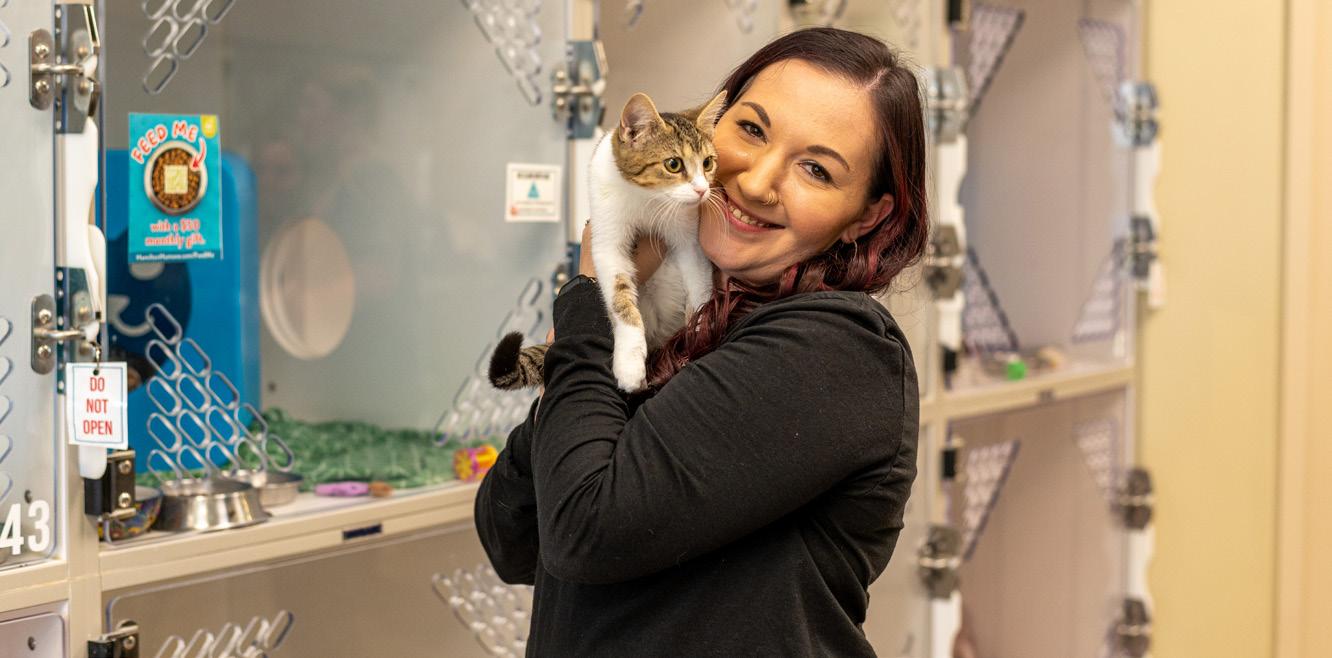
“I’ve had vets that don’t want a clingy animal and vets that want an animal that will protect them. There are social butterflies and some that don’t want to leave the house.”
They get to know the animals, too — whether they’re aloof or outgoing, quiet or yappy, tranquil or excitable, whether they get along with other dogs, cats, or children, and what their former living conditions were like.
And when pet meets vet, Smola expects love at first bark … or meow.
“We want to make sure there’s a connection — that sparks are flying,” she said, sounding more like the proprietor of a matchmaking service.
“We want to make sure the animal checks all the boxes. They have to be able to meet each other’s needs.”
Whether it’s pet adoption or people dating, opposites don’t necessarily attract. Some animals that jump at the sound of fireworks or thunderstorms do well with veterans who also flinch at boisterous bursts.
continued on page 22
continued from page 21
‘WE SAVED EACH OTHER’
And some of the most traumatized pets find happiness with some of the most traumatized owners — as in the case of a dog named Caesar and his adoptive “mom,” Army veteran Emily Pence, who has PTSD. But hers didn’t come from the horrors of war. Assigned to a Patriot battery in Germany, Pence was sexually assaulted by a male superior. Too intimidated to report the offense, she left the service the following year, but continued to suffer psychologically after her discharge.
It’s a plight that Smola knows well. “I didn’t serve in the military,” she said, “but I have severe PTSD, anxiety, and depression due to being sexually abused throughout my childhood. That’s why I relate to shelter animals, because they have obviously been failed by someone in their life.”
I
Pence was nearing her emotional limit by the time she went looking for a canine companion at the Humane Society. “My PTSD and my anxiety were really high,” she said. “I was lucky to sleep two or three hours a night. It’s like the old saying goes, if I hadn’t gotten help, I would be six feet under or behind bars.”

just had this feeling when I got close to him. Like he was mine, and I felt the love. I wanted to bring him home that day.
a lady came up behind me and said, ‘Are you Emily?’” she recalled. “I looked at a dog I’d seen online, and there was just no connection. Then she brought out Caesar. But before she brought him out, she told me his story.”
lacked a no-kill policy and might have euthanized all three of them had the Humane Society for Hamilton County not stepped in to take custody of the trio.
She had seen a flyer for Pets Healing Vets, and her youngest son encouraged her to get a dog. Pence pored over the dog photos on the Humane Society website, chose seven possible pets, and arranged to see them in person. “I walked in and
It was not easy to hear. The 70-pound pit bull terrier had lost his previous home under ghastly circumstances: A mass slaying claimed every human occupant but one. Police took Caesar and his two siblings to a shelter, but it
What transpired between Pence and Caesar had nothing to do with sympathy. “When she brought him out, it was instantaneous,” she said. “I just had this feeling when I got close to him. Like he was mine, and I felt the love. I wanted to bring him home that day.” It took another month for his “Gotcha Day,” as pet owners refer to the day they bring home an adopted animal, but in 2021, she took ownership of the forlorn pooch.

Now she’s sleeping better and feeling the same comfort that Justin Morseth found when his dog became a snuggler. “When I’m sick, Caesar is right by me,” said Pence, who resides near Lapel. “When I’m having a bad dream, he will get up close to me as much as he can. I think we kind of saved each other.”
A SOCIAL BUTTERFLY
The day Jose Sierra came to the Humane Society to get a dog, they showed him three — after which Sierra couldn’t make up his mind. “We’ll talk about it,” he said, but the discussion didn’t last long. He was
Now
quickly overruled by his fiancée, Sarah Evans, who had sat in on the session.
“No, we’re getting Hank,” she told Sierra, recalling the pitbull-boxer mix they had seen. “You seemed to click with him.” And seven years later, it’s obvious she made the right call.
Back then, Sierra was mired in depression after a brain injury prompted his medical discharge from the Army. On top of that, the Tennessee native had moved to Indiana to join his parents, who came here for an employment opportunity. “I’m usually a social person, but I
“ “
didn’t know anybody here. And I didn’t want to go by myself,” he said, “so I would just work and go home.”
that he’s here, I’m forced to go out and walk him, talk to other people walking their dogs, and socialize.
Enter Hank, whom Sierra described as a social butterfly.
“Now that he’s here, I’m forced to go out and walk him, talk to other people walking their dogs, and socialize,” said Sierra, of Cicero. It’s not surprising that he chose a rescue dog over a pooch with a pedigree. He grew up with parents who belonged to a volunteer rescue team for pit bulls.
Hank had lived with two previous families and was found wandering behind a Walmart. Life has improved considerably since. Besides paying for his food and veterinary care, Pets Healing Vets even covers the cost of nail trimming.
And it never hurts to get spiffed up, especially for a dog that’s mastered the art of cultivating human attention at dog parks. “Hank just ignores the other dogs now,” said Sierra. “He goes and meets the owners. He kisses babies and kids like he’s President.”
AN INSTANT BOOST TO LIFE
Eric Smith’s introduction to a coonhound named Dolly wasn’t exactly a match made in heaven.
“They brought her out and gave me some treats to give to her,” he recalled. “She wasn’t interested. She was looking at a squirrel in a tree.”
continued on page 24
The Humane Society had five other adoptable dogs waiting in the wings for his consideration. Yet Smith waved them off and motioned toward Dolly. “That’s the one,” he said.
Her independent attitude appealed to Smith, who wasn’t looking for a high-maintenance pet that demanded constant affection — just a companion. His life in and after the military may have had something to do with that. Wounded only six months into his deployment to Iraq, he wound up blind in one eye, out of the military on a medical discharge, and feeling lost and lonely. “Once you leave the Army, you lose that camaraderie,” said Smith, of Lebanon.
“It put me in a deep, dark depression. I was an extrovert, but when depression set in, it turned me into an introvert.”

I’ll go into a room when she’s in it, and she will leave that room. She’s not a clingy dog, which works for us both.
He spent the next decade heavily medicated for depression and PTSD, but neither that nor extensive therapy coaxed him back into the civilian world.
His parents suggested getting a companion animal, and while checking out animal shelters, Smith discovered Pets Healing Vets. And before long, he was saying, “Hello, Dolly!”
Despite her detached nature, or perhaps because of it, Dolly has changed her owner’s life in tangible ways. Smith seems to regard her with a sense of bemusement, recounting her quirky behavior in a dry, observational style. For instance: “She’s a very lazy dog. She doesn’t
“ “
even like toys. I haven’t found one she likes, not even a ball.
I’ve even taken her to PetSmart, and she wasn’t impressed with the toys.” Or: “I’ll go into a room when she’s in it, and she will leave that room. She’s not a clingy dog, which works for us both.”
But Dolly has provided more than entertainment. She was an “instant boost” to his life, enabling him to cut back significantly on his medication, he said. Smith has also re-entered the workforce, transporting elderly patients to medical appointments.
“It’s got me out talking to people, interacting,” he said. “I love their stories. I’m a big history nerd and
like hearing their version of what happened. I’m feeling closer to normal.”
Smith isn’t where he was before his combat injury and will never be exactly the same. But for a young veteran who spent a decade in the grip of PTSD and depression, there’s reason enough to celebrate a certain blasé coonhound, not to mention the shelter and its adoption program that brought her into his life. “You can tell they’re there for the right reasons,” he said of the Humane Society. “They care tremendously for the animals.”
They care tremendously for the veterans, too, often bestowing, for at least a few hours a day, the greatest gift they could give a PTSD patient — peace of mind, even if it takes a tail-wagging courier to deliver it.
•
•


EATING AND education
The Courses Restaurant at Ivy Tech Indianapolis prepares students with real-world culinary experience
By Chris Adam
Some Ivy Tech Community CollegeIndianapolis community members call it a “hidden treasure” for the city. It’s also a place where education and fantastic food come together to serve neighbors.
A STUDENT-RUN RESTAURANT
The Courses Restaurant is a studentoperated eatery run by Ivy Tech Community College-Indianapolis. It operates as part of the college’s hospitality, culinary arts, baking, pastry, and related programs. The restaurant is tied into faculty-led courses, called cuisine courses, that rotate through themes such as classical French cuisine and specialized cuisine from around the world. Courses Restaurant is meant to give students real experience in preparing food, cooking, serving, performing front-of-house duties, and more.
“Every day in the Courses Restaurant, I get to watch our students transform their classroom lessons into real-world excellence,” said Chef Jenni Schouppe, program chair of the School of Culinary Arts and Hospitality Management, Indianapolis campus.
“Seeing their confidence grow as they serve the public and refine their craft is the best part of my job. Their passion for hospitality and culinary arts reminds me why this work matters. It’s not just about food, it’s about building futures.”
A RICH HISTORY
The restaurant and the bakery are student-run operations in the Ivy Tech Indianapolis Conference Center and Culinary Institute on the college's downtown campus. The restaurant is on the penthouse floor, and the bakerycafé is in the first-floor lobby.
The building at 2820 North Meridian Street, Indianapolis, which now houses Ivy Tech’s Conference Center and Culinary Institute, was originally the Stouffer’s Hotel, built in 1965.
Before being the Stouffer’s Hotel, the property was the site of the mansion of Frank Van Camp, famous for Van Camp baked beans. The mansion was built in the late 1800s.
Ivy Tech purchased the building in December 2010. The Conference Center and Culinary Institute at Ivy Tech opened in August 2012, and the restaurant also opened as part of the facility.
LEARNING ON THE JOB
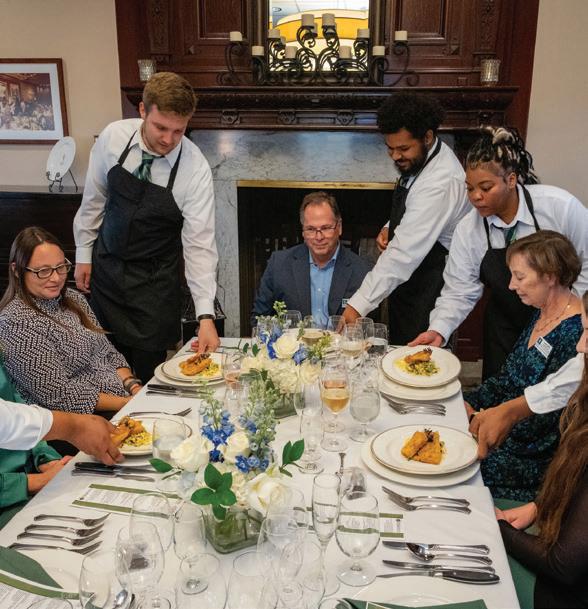
Students in culinary arts, baking and pastry, and hospitality management/ customer service classes participate in restaurant operations. Culinary courses are eight weeks long. When the restaurant is open, students prepare the menu based on the theme of the class.
For front-of-house/customer service, there is a specific class that brings together students from culinary, baking, and hospitality management to run a dining room experience and develop leadership, communication, and teamwork skills. Students also earn certifications as part of the curriculum.
The restaurant is open to the public during the fall, spring, and summer semesters for lunch and dinner, depending on the class schedule. Reservations are required to dine there. The cost is fixed for three courses at lunch or dinner. A portion of each meal price, plus 100% of tips, goes toward the student scholarship fund.



























FLEECE-LINED TASLON® ANORAK JACKET. Soft, removable fleece lining. Chest welt and front pockets. Taslon® nylon/poly. Machine wash. Average: 29-59789-1233
32" length. Petite: 29-36821-1233
30" length. Classic Red, Waterfall, Navy, Bark or Black only. Sizes M-6X




















Wabash Valley Power news
GRATEFUL FOR GROWTH, GROUNDED IN PRINCIPLES

ThisNovember, I’m especially mindful of the blessings in my life — my family (even if my kids may not love that I am sharing this photo), my friends, and the incredible team at Wabash Valley Power Alliance dedicated to serving you. It’s the perfect time to reflect on the work we do together as a cooperative family and thank you for trusting us every day to deliver reliable, affordable energy and prepare for the future.
One of our biggest goals this year as an organization was preparing to serve up to 1,000 megawatts (MW) of new growth. What does that mean? On the hottest days of the summer, when everyone’s air conditioners are running at once, our system collectively uses about 1,800 MW of electricity at its peak. So, adding 1,000 MW over the next five years is significant.
I understand there are concerns about large projects like data centers. This year alone, we received about 150 economic development requests, many of them we would call “mega loads.” When a new home or business is built in REMC territory, our distribution co-op has certain legal obligations to serve under Indiana service territory law. With very large projects, though, we take additional steps. Before they come to a community, we make sure the power is available and can be delivered reliably. We also require strong financial protections and, just as important, support from the local co-op. When done right, these opportunities strengthen local communities and our entire Wabash Valley Power membership. When one member benefits, we all benefit.
As we pursue growth, we remain grounded in three core principles:
• Creating meaningful value — Every project must deliver long-term benefits for all our members, not just a few.
• Risk mitigation — Growth is exciting, but it must be carefully managed. We design agreements that protect members from uncertainty, ensuring stability and confidence.
• Responsible solutions — Energy decisions affect more than kilowatts and costs; they shape communities, economies, and futures. That is why we focus on practical solutions.
These principles guide every conversation, negotiation, and agreement. They remind us that growth without purpose is not success; it’s risk. Our focus is always on our co-ops. Like local REMCs, we are not-for-profit. We do not answer to shareholders in faraway places. Growth that brings value, protection, and responsibility sets co-ops apart.
So, this November, as we give thanks for families, communities, and the blessings we share, I am thankful for you, our members. Your trust, partnership, and belief in the co-op model make progress possible. Together, we are not just securing megawatts. We are building a stronger future. And for that, I am grateful.
Jeff Conrad President and CEO Wabash Valley Power Alliance
BUILDING PROJECT UPDATE

one year of progress Celebrating
One year ago this month, Boone Power (then known as Boone REMC) broke ground on our facility improvement project at our current location on Indianapolis Avenue in Lebanon. We’re excited to share that one-third of the project is now complete!
Four of the five buildings have started construction. The three on the south side of our property, which will be for storage, maintenance, and training, are set to be finished in the next few months.
Floors have been poured, and mechanical and HVAC work has started on our main administrative building, which we hope to move into sometime in 2026. We will continue to provide any changes to the procedures for visiting our office in this magazine, on our website, and via our social media channels.
Since moving into our current administration building in 1999, we've experienced a 152% increase in the number of active meters we serve. This growth has highlighted the need for additional space to accommodate our expanding team and equipment. Our existing facilities have limited capacity for workstations, covered storage, and parking, and the height of our operations buildings does not accommodate maintenance on bucket trucks.
Additionally, we've faced ongoing maintenance challenges in our current buildings. The decision to build new facilities ensures we can continue to serve our members safely, effectively, and efficiently.
To learn more about our facility improvement project, watch a short video with our construction firm and read through FAQs at boonepower.com/new-facility
SURVEY COMING SOON
We're partnering with our wholesale power provider to determine future power needs.
You may receive an email some time in November or December asking you to participate in a survey of residential co-op members. The survey helps our wholesale power partner, Wabash Valley Power Alliance, plan power needs for the future and shape programs we can offer to our members. The consumer information received guides decision making by WVPA and its member electric distribution co-ops like Boone Power. Thank you in advance for taking time to complete the survey!

The treasure of sandbars

ecause I no longer have a day job, I sometimes spend the cool, blue afternoons of autumn on a nearby creek, wandering. The stream turns and turns and turns. In fact, the Big Raccoon bends itself so often that anyone walking its banks or kayaking its water will, sooner or later, be headed in any direction the compass can point.
With nearly each of those pivots, the creek sprouts sandbars like weeds. They are places — along with the occasional ankle-deep shoal — that supply me with entertainment, for I’m an inveterate collector of stones and fossils, driftwood, and snail shells.
I asked a geologist a few years ago how sandbars formed, and his explanation seemed tailor-made for that creek. He told me that sandbars in “meandering streams” are formed when water in the middle of a straight channel travels at a high velocity, and when that water reaches a bend, it runs fastest toward the outside, leaving less velocity in the flow on the inner bank.
The inside of the curve collects more of the eroded sediments that the

faster-moving waters glean from the outer banks, so a sandbar piles itself up. Along with the fine sand dredged from the banks and scoured from the creek’s bottom, gravel and whatever else has been tossed or dumped or fallen into the stream are deposited. I can always fill a bag with the ever-present aluminum cans, the occasional boot, the jagged glass of decadesold canning jars, but I also rake in a treasure trove of crinoids and horn corals, polished coal and water-tumbled quartzes, deer antlers, and once even a centuryold medicine bottle.
Of course, sandbars also give me places to walk out onto the creek. They let me get alongside it, wade in it, smell it. They are places where the living things of the surrounding woods emerge into the open from behind green leafy curtains and show themselves. On one sandbar near the farm my in-laws lived on for over
half a century, I regularly witness a menagerie: the whimsy of blue damselflies, the unexpected speed of diving soft-shelled turtles, the determination of leaf-toting muskrats, the elegance of wading deer, the singlemindedness of water-sipping goldfinches, and on more than one occasion, raccoons that swam the width of the creek in the fading light of warm evenings.
Although we manage to get our grandsons to the creek some, I mostly walk the sandbars alone now, stooping every so often to pick up a bit of polished glass or weathered wood, but also to stand and watch puddling butterflies or passing hawks. Sandbars are places worth knowing.
Mike Lunsford is a freelance columnist, feature writer, and photographer based in Parke County. Contact Lunsford at hickory913@gmail.com.

Leave a legacy for future generations, nothing embodies this sentiment quite like the enduring gift of gold from American Gold Reserve. With its intrinsic value and historical significance, gold represents stability and prosperity across generations, making it a cherished asset to pass down. Secure your family’s future with a gift that stands the test of time, ensuring legacy of financial security and enduring value.
American Gold Reserve is releasing Government issued $5 Gold American Eagles completely free of dealer mark-up for only $369 each. These beautiful $5 Gold American Eagles are a perfect way to enter the gold market. They are set for immediate public release and will sell out fast.


• Teach the importance of wealth
•
• A symbolic act of the commitment to your family.
• Gold provides your children and grandchildren with a built-in safeguard during times of financial instability.





















